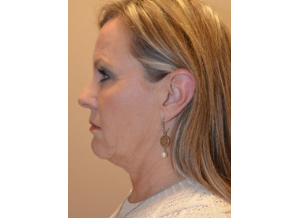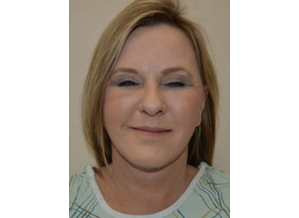Serving Colleyville, Mid-Cities, Dallas, Fort Worth, Plano, Southlake, Grapevine, Irving, Arlington, Mansfield, and the surrounding areas.
Unfortunately, youthful good looks don’t last forever. The face and neck are exceptionally vulnerable areas that are easily affected by sun damage, thinning skin, smoking, and stress. While wearing sunscreen and leading a healthy lifestyle will make a difference, if you’re already unhappy with certain changes in your face, you’ll see the most dramatic improvement with cosmetic surgery. One of our board-certified and fellowship-trained cosmetic surgeons can overcome the common signs of aging—or even get ahead of them—with a custom facelift that gives you a natural look.
Facelift: Overview
A facelift, or rhytidectomy, is a surgical procedure that can repair the following:
- Relaxed skin that causes sagging in your face
- Deepened fold lines between the nose and corner of the mouth
- Fat that has fallen or disappeared
- Jowls in your cheeks or jaw
- Loose skin and excess fat in your neck area that creates a double chin or “turkey neck”
Who’s Eligible for a Facelift?
Facelift surgery is a highly individualized procedure. You should do it for only yourself, not to satisfy someone else’s desires or to try to fit any particular image. Your doctor will do a full evaluation, but you’re a good candidate for a facelift if you:
- Are a healthy individual with no existing medical conditions that would impair healing
- Are a non-smoker
- Have a positive outlook with realistic expectations of the surgery
Facelift Techniques
After a thorough evaluation, your doctor will recommend the best of three primary facelift techniques for you.
1. Mini Facelift
If your face and neck have mild jowls or sagging skin, you could be a good candidate for a mini facelift. This technique is less invasive than a traditional facelift. It includes smaller incisions and may be performed with local anesthesia. A mini facelift can address signs of aging early, postponing the need for extensive surgery.
2. Traditional Facelift
To address “turkey neck,” as well as deep folds and wrinkles, your doctor may recommend a traditional facelift. This procedure involves larger incisions and more recovery time, but the results tend to be more dramatic.
3. Neck Lift
If you are only interested in improving the appearance of your neck, your surgeon can address this through a small incision behind your chin. This procedure is performed under local anesthesia.
Does a Facelift Cause Scars?
Because facelift surgery involves incisions, scarring is possible, but incisions run behind the hairline and ears. Hidden in the natural folds of your face, facelift scarring is never visible. You can also minimize the appearance of scars with proper post-surgery skin care.
Facelift Surgery: The Consultation
Our top priority is patient care and safety. You can anticipate a thorough consultation. If you have questions about the procedure, use your consultation to ask your doctor. He’ll take ample time to address any concerns you have. He’ll also go over the following:
- Your desired outcome and expectations
- Your family medical history
- Any previous surgeries you’ve had
- Any existing medical conditions
- Your current use of alcohol, tobacco products, supplements and/or prescription medications
- Any known allergies
- The use of anesthesia during your facelift procedure
- Any potential risks of the procedure
Also expect your doctor or one of our medical associates to take photographs of your face. Your doctor will use these images to assess your cosmetic needs and make the best recommendation. All photographs are kept in your medical records, so you can view the change in your overall appearance after facelift surgery.
Facelift Surgery: The Procedure
Our board-certified and fellowship-trained cosmetic surgeons perform facelift surgery at our surgery center in Southlake, TX. You may be given certain facial products that prepare skin for surgery. You also may be asked to:
- Adjust your current medications
- Stop smoking
- Avoid taking herbal supplements, aspirin, and other over-the-counter anti-inflammatories
For your comfort and safety, arrange a friend or family member to drive you to and from surgery. If you’re undergoing a traditional facelift, expect to be in surgery for three to four hours. It can take up to six hours when combined with other procedures, such as a neck lift or brow lift. Most mini facelifts are performed in under two hours
Whether you’re getting a mini facelift or a traditional facelift, your doctor will follow the same basic steps:
Step 1: Administering anesthesia either by local anesthesia, intravenous sedation, or general anesthesia. Your surgeon will discuss the best option for you.
Step 2: Placing incisions depending on the facelift technique your doctor and you agree on. For a traditional facelift, an incision begins behind the hairline, at your temple, and follows your hairline down around your ear and back toward your lower scalp. For a mini facelift, the surgeon makes shorter incisions that start at your temple and continue down around your ear. Incisions usually don’t go past the ear. For a neck lift, only one incision behind the chin is required.
Step 3: Removing or re-positioning fat. Deeper layers of the face and muscles are lifted and re-secured to define the contours of your face. Your doctor removes excess skin, leaving you with a tighter, firmer appearance. To lift a sagging neck, a second incision may be drawn under your chin.
Step 4: Closing incisions with sutures or skin glue. Sutures will either dissolve on their own or need to be removed at a later date. For optimal results, a facelift is often combined with a neck lift, brow lift, or eyelid lift. In these cases, your doctor will perform multiple procedures in one operation.
Facelift: Post-Surgery Care & Recovery
Immediately after facelift surgery, your doctor will likely apply a bandage around your face to minimize bruising and swelling. You may also have a small tube inserted at your incisions to drain excess blood and fluid. These open sites will need proper cleaning and care to prevent infection and promote healing. Even with bandaging, you’ll likely experience some bruising and swelling. These symptoms tend to peak two days after facelift surgery and then gradually improve as you heal. While you’re healing, wear sunscreen and a wide-brimmed hat. Post-surgery, your face will be extremely sensitive to sun exposure. Keeping it protected from the sun helps healing and reduces scarring. After 24 to 48 hours, you’ll return to our office for a follow-up visit. At that point, he will likely remove the sutures (unless they dissolve). Most facelift patients can resume their daily routines within two weeks. Four weeks post-surgery, you should be cleared for more strenuous exercise.
Risks of Facelift Surgery
Like any facial rejuvenation, it’s important to understand the potential risks as well as you do the results. At DFW Center for Aesthetics and Cosmetic Surgery, you will be asked to sign consent forms before your facelift surgery to ensure you fully understand the procedure. Facelift risks include:
- Facial nerve injury or weakness that can cause numbness
- Discoloration or other skin irregularities
- Deep vein thrombosis, cardiac, or pulmonary issues
- Temporary or permanent hair loss at the incision sites
- Fluid accumulation
- Bleeding from the incisions
- Issues with wound healing, which may lead to infection
- Unfavorable scarring
- Persistent discomfort
- Anesthesia complications
These risks will be thoroughly discussed during your consultation and prior to consent. If you’re not completely satisfied with your results, your doctor will discuss revisional surgery or may recommend a different cosmetic procedure.
How to Pay for Facelift Surgery
Our office accepts healthcare credit cards issued by Synchrony Bank (CareCredit®) and Comenity® Capital Bank (Alphaeon Credit®). Should you need it, we will accept a secured loan from United Medical Credit or Enhance Patient Finance. United Medical Credit is suitable for prime and subprime lenders and has multiple plan options with flexible terms. The following payment methods are always accepted:
- Credit card
- Cash
- Cashier’s check
- In-house financing
- Other types of loans
A facelift can turn back the clock, helping restore your youthfulness—and your confidence. Don’t wait to discuss your options and get a customized plan to meet your needs. Call the medical professionals at DFW Center for Aesthetics and Cosmetic Surgery to request an appointment and make your cosmetic dreams come true.










